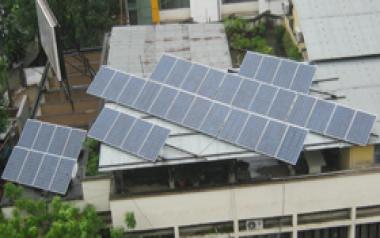There is a large potential available for generating solar power using unutilized space on rooftops and wastelands around buildings. Small quantities of power generated by each individual household, industrial building, commercial building or any other type of building can be used to partly fulfill the requirement of the building occupants and surplus, if any, can be fed into the grid. The roof-top SPV systems on building’s roof space can be installed to replace DG gensets for operation during load shedding.
The price of power generated from solar plants installed today is at par with or lower than the commercial tariff for consumers. The cost of solar power is on the decline trend while the cost of fossil fuel based electricity is increasing day by day.
The cost of generating solar power at present is a little higher than the tariff charged from consumers by Distribution Licensees/DISCOMS in most cases (other than commercial). With the capital subsidy (upto30%) or so, it may be possible to generate power between Rs.5.0 -6.50 per unit for the next 20 years, which is cheaper than the diesel gen-set based electricity and this could also be cheaper than the cost at which most Distribution Licensees/DISCOMS would make power available to the same consumer. It is therefore important to popularize the use of solar energy so that people gain confidence and then its use can increase on its own.
In grid connected rooftop or small SPV system, the DC power generated from SPV panel is converted to AC power using power conditioning unit and is fed to the grid either of 33 kV/11 kV three phase lines or of 440/220 Volt three/single phase line depending on the capacity of the system installed at institution/commercial establishment or residential complex and the regulatory framework specified for respective States. They generate power during the day time which is utilized fully by powering captive loads and feed excess power to the grid as long as grid is available. In case, where solar power is not sufficient due to cloud cover etc., the captive loads are served by drawing power from the grid. The grid-interactive rooftop system can work on net metering basis wherein the beneficiary pays to the utility on net meter reading basis only. Alternatively two meters can also be installed to major the export and import of power separately. The mechanism based on gross metering at mutually agreed tariff can also be adopted. Many such power plants can be installed at the roofs of residential and commercial complex, housing societies, community centers, government organizations, private institutions etc.
Ideally, grid interactive systems do not require battery back-up as grid acts as the back-up for feeding excess solar power and vice-versa. However, to enhance the performance reliability of the overall systems, a minimum battery backup of one hour of load capacity is recommended. In grid interactive systems, it has, however to be ensured that in case the grid fails, the solar power has to be fully utilized or stopped immediately feeding to the grid (if any in excess) so as to safe-guard any grid person/technician from getting shock (electrocuted) while working on the grid for maintenance etc. This feature is termed as ‘Islanding Protection’.
The grid connected rooftop solar photovoltaic power generation plants, generates electricity at the consumption center and hence contributes to reducing the network losses of the distribution licensee. The electricity generation shall also contribute to meeting the demand and supply gap and shall also enable the obligated entities for complying with their solar purchase obligation targets as specified by appropriate Electricity Regulatory Commissions’. India has a huge potential for deployment of grid connected rooftop solar photovoltaic power generation plants and the MNRE envisages harnessing this potential.
https://mnre.gov.in/img/documents/uploads/file_f-1595328067505.pdf
For details click below
